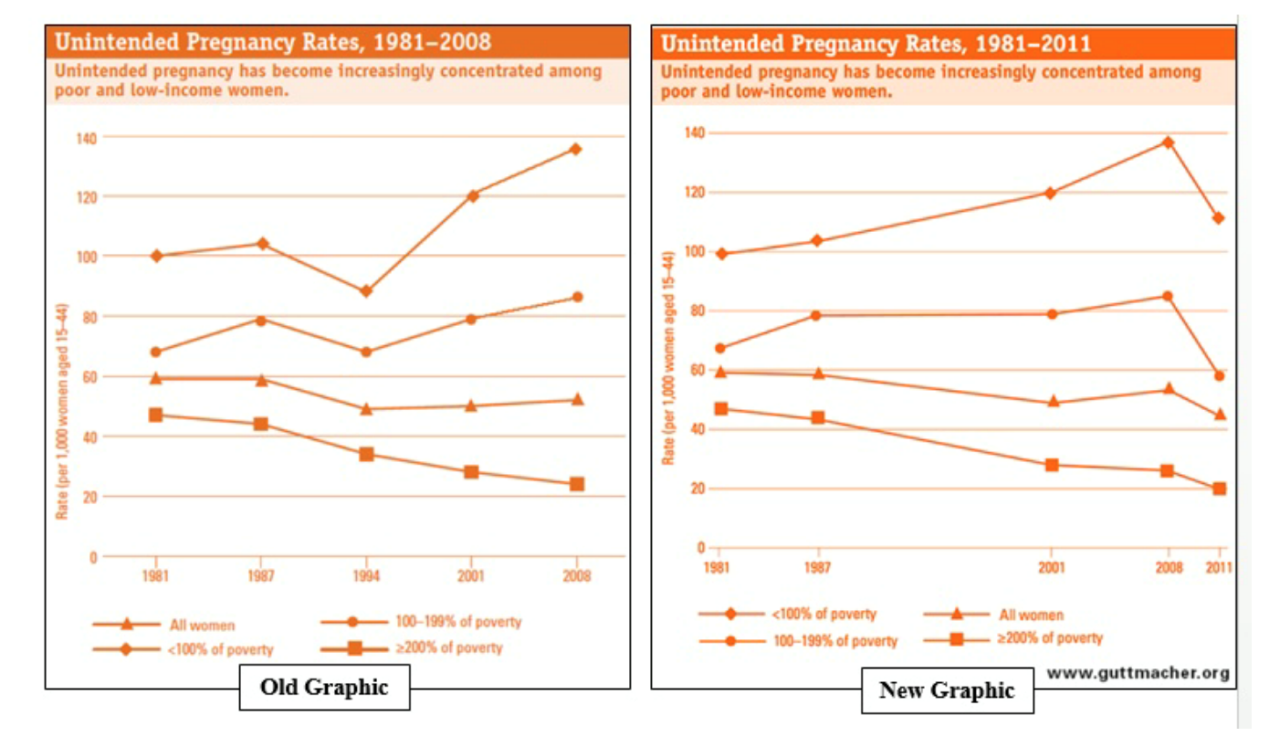The Guttmacher Institute, the research arm of Planned Parenthood Federation of America (PPFA), reportedly erased data to suggest that the nation’s largest abortion provider, and intrauterine devices (IUDs), have both worked to substantially reduce unintended pregnancies.
Writing at The Federalist, Willis L. Krumholz asserts that the Guttmacher Institute has fudged its data in order to protect the abortion business.
Krumholz says that Guttmacher also shaded its data in favor of Planned Parenthood in March in its new report on unintended pregnancies in the United States. A data plot graph appeared showing unintended pregnancy rates from 1981-2011, but did not include the data plot for 1994.
“This is important: that 1994 data point showed that unintended births among poor women were declining before Planned Parenthood or the intrauterine device (IUD) came along, but quickly reversed as PPFA’s market share and competitive position strengthened,” explains Krumholz. “Then, around April 2, 2016, the new ‘smoothed’ graph was oddly removed from the main press release, and the URL was changed due to a website update.”
Krumholz further explains that, following a national Planned Parenthood strategic “reinvention process,” the abortion business experienced a marked increase in its market share, measured by abortions, and sharp rise in revenue – from $400 million in 1990 to $1.3 billion today.
“The truth is that unintended pregnancy rates were falling until the mid-’90s and then they suddenly shot up,” he writes, adding:
Why did they shoot up? If IUDs are so great, why was the unintended pregnancy rate lower in the early ’90s, before IUDs were as widely used? If Planned Parenthood is so great, why was the unintended pregnancy rate lower in the early ’90s, before Planned Parenthood tripled its market share?
Breitbart News reached out to Guttmacher for comment on the claims. Joerg Dreweke, the research center’s senior policy communications associate, said he has demanded a retraction or correction from Krumholz on Twitter:
The premise of this @micaiah157 @LifeNewsHQ article is false https://t.co/WHMBcrFBO0. See my timeline for details. Pls correct or retract.
— Joerg Dreweke (@JoergDreweke) April 13, 2016
Dreweke continued:
The short of it is that the central premise of the piece is false. Our unintended pregnancy analysis is based on data from the federal National Survey of Family Growth (NSFG). Since our last update of national unintended pregnancy data we became aware that the NSFG believes the 1994 data on pregnancy intendedness (based on 1995 surveys) are unreliable. Specifically, the NSFG says that “research suggests…1995 data may show a bias toward higher [%] intended, for methodological reasons.” See p. 27 here for their full explanation: http://www.cdc.gov/nchs/data/nhsr/nhsr055.pdf
In other words, the 1994 unintended pregnancy data in our chart were artificially low, according to NSFG. That’s why we omitted this data point in our most recent analysis. All of this is, of course, explained in our New England Journal of Medicine study where we published these data.
Our researchers followed best research practices and were fully transparent about it. Unfortunately, Mr. Krumholz never read the study where our data were published.
Krumholz tweeted in reply:
@JoergDreweke @Guttmacher @FDRLST I stand by the article. https://t.co/6MxbuaAo8y …Response forthcoming.
— Willis Krumholz (@WillKrumholz) April 12, 2016
“At best, this is Guttmacher trying to further the false narrative that IUDs and Planned Parenthood are finally beating the tide of unintended pregnancies,” he asserts. “At worst, this is Guttmacher trying to cover for PPFA, whose ascendancy corresponded with worse outcomes for the women it claims to serve.”
In February, Krumholz observed that, in an attempt to prop up Planned Parenthood, Democrat Rep. Gwen Moore had falsely argued at the Washington Post that the abortion provider does not “’target’ the black community.”
He explained:
Moore begins by citing a commonly used Guttmacher Institute statistic (Guttmacher is Planned Parenthood’s research arm): “fewer than 1 in 10 abortion providers are in majority-black neighborhoods.”
This statistic is spurious. Because black Americans comprise only 12 percent of the U.S. population, relatively few areas in America are majority black. By neighborhood, Guttmacher means ZIP code. Only 2 to 4 percent of U.S. ZIP codes have a majority black population. Only 3 percent of counties have a majority black population.
Using Guttmacher’s own findings, however, almost 10 percent of America’s high-volume abortion clinics (performing more than 400 abortions per year) exist in those majority-black ZIP codes. Clinics in neighborhoods where non-whites are the majority, only around 15 percent of U.S. neighborhoods, make up 40 percent of all abortion clinics in the United States. This means that, even on Guttmacher’s own showing, abortion clinics are indeed disproportionately found where the local population is predominantly minorities.
Planned Parenthood itself was founded by eugenicist Margaret Sanger, who hoped to control the black population and “eliminate the stocks [of people] that are most detrimental to the future of the race and the world.”
According to the Centers for Disease Control and Prevention (CDC), 40 percent of pregnancies among black women end in abortion. And in New York City – home of the headquarters of Planned Parenthood – more black babies are aborted than are born.
“Abortion clinics do disproportionately reside in minority neighborhoods,” Krumholz states. “This is no conspiracy. Rather, it makes business sense for Planned Parenthood to reside in urban areas with high concentrations of people, of which a high portion are poor.”


COMMENTS
Please let us know if you're having issues with commenting.